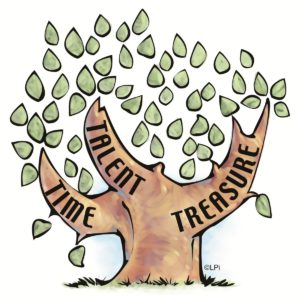Why should we ask this question?
As an early-stage investor, the first test for me is whether “my” entrepreneur is flexible in both the plan and execution of their vision (since from experience almost everything about a business plan changes over time), and whether that person, no matter what age or experience, is coachable.
both the plan and execution of their vision (since from experience almost everything about a business plan changes over time), and whether that person, no matter what age or experience, is coachable.
Doctoral theses have been written on this subject.
Early-stage investor groups often list these traits at or near the top of their list when filtering opportunities for investment. And I have numerous stories from personal experience that reinforce these two traits as the most positive indicators of future success in business.
Teaching about the five types of resources
In my book, “Extending the Runway” (Second Edition, Berkus Press 2014), I explore the thesis that there are five basic types of resources an entrepreneur must exploit in growing a successful business: time, money, process, relationships and context. Understanding the effects of each upon an entrepreneur and early-stage business plan is critical. Being able to adapt to the realities and changes in the fast-moving environment is essential.
Let’s test your flexibility.
Flexibility: the context in which a business plan envisions the enterprise in its marketplace is constantly changing as new products and services challenge competitors to innovate and adapt. A plan written last month may easily need tweaking this month to recognize changes in the marketplace, the central context of the plan itself. Are you tuned in to those changes, no matter how small?
Speed of change is inevitable.
[Email readers, continue here…] Everything happens faster these days than even a few years ago, especially in the arena of technology, where many new businesses are developed each month to solve problems or take advantage of opportunities that existed at the moment of an entrepreneur’s vision for the future.
A recent example:
The advent of ChatGBT and other artificial intelligent applications took us by surprise but changed the rules for many managers and workers in numerous fields. Did you take the time to study then discuss these implications with your staff or leaders?
Using our relationships to speed adaption
 One of the best indicators of future success for an entrepreneur and an early-stage idea is the quality and depth of great relationships with industry veterans or technology gurus, or experienced successful business leaders. Those relationships would be impressive but worthless if the entrepreneur was not coachable, open to suggestion and criticism from those who have experience enough to surface the issues unspoken but obvious to the coach.
One of the best indicators of future success for an entrepreneur and an early-stage idea is the quality and depth of great relationships with industry veterans or technology gurus, or experienced successful business leaders. Those relationships would be impressive but worthless if the entrepreneur was not coachable, open to suggestion and criticism from those who have experience enough to surface the issues unspoken but obvious to the coach.
Coaches have seen your movie before.
And finally, there are always ways to improve the process of design, testing, roll-out and marketing a new idea. And many potential coaches out there have made mistakes in these processes at the expense of their employers or even their personal savings. Since we all learn from our mistakes, it seems reasonable that we should learn from the mistakes of others, particularly those who freely offer their experiences as lessons for our enterprise.
It’s true: Many of us will ignore the advice.
I’ve seen entrepreneurs go through the complete process of raising money for a business from investors, many of whom were experienced and well beyond just friends and family, only to ignore all advice and execute a flawed business plan to death, ignoring the pleas and attempts at coaching by others including those investors.
Don’t be one of those. Be flexible and be coachable.


 Considering the alternatives early in the timeline helps you to monitor growth in terms of valuation, weigh the value of continued investment, bring family members into the discussion, and picture the end game in your mind.
Considering the alternatives early in the timeline helps you to monitor growth in terms of valuation, weigh the value of continued investment, bring family members into the discussion, and picture the end game in your mind. didn’t even think existed – from CEOs who couldn’t control the euphoria. A successful test. Completion of a software project by the remote workers in (Philippines, Brazil, Armenia, fill in the blank… Just name a country whose daytime is our nighttime.) You get the idea.
didn’t even think existed – from CEOs who couldn’t control the euphoria. A successful test. Completion of a software project by the remote workers in (Philippines, Brazil, Armenia, fill in the blank… Just name a country whose daytime is our nighttime.) You get the idea. when you are at or near that right point to sell for maximum value? Those of us in the business of calculating (guessing) this mythical peak in value often make the same mistake as our entrepreneurs. We hang on just a little bit longer, expecting continued or accelerating growth and value as in previous periods of the same.
when you are at or near that right point to sell for maximum value? Those of us in the business of calculating (guessing) this mythical peak in value often make the same mistake as our entrepreneurs. We hang on just a little bit longer, expecting continued or accelerating growth and value as in previous periods of the same. For young companies, often the question is whether to suffer a new round of dilution to stimulate growth, or to sell earlier and not share the (presumably) increased proceeds with additional investors. Not so long ago, Basil Peters wrote his book, “Early Exits,” after analyzing 150 young companies and their exits. He concluded that the sweet spot for valuation was in the $20–30 million sales price range, and that many, many times more deals were completed in that range than above $100 million in valuation at exit. Adjusting these numbers to fit your circumstance, the conclusion is that waiting for higher value after sustained growth becomes more and more of a risk in the majority of early stage cases.
For young companies, often the question is whether to suffer a new round of dilution to stimulate growth, or to sell earlier and not share the (presumably) increased proceeds with additional investors. Not so long ago, Basil Peters wrote his book, “Early Exits,” after analyzing 150 young companies and their exits. He concluded that the sweet spot for valuation was in the $20–30 million sales price range, and that many, many times more deals were completed in that range than above $100 million in valuation at exit. Adjusting these numbers to fit your circumstance, the conclusion is that waiting for higher value after sustained growth becomes more and more of a risk in the majority of early stage cases. assets (including cash) in its corporate income tax audits. This insight addresses more the impact of such behavior upon the actions of employees and others who observe that behavior from a senior manager or owner of a business – and know that they cannot say anything about it without jeopardizing their jobs.
assets (including cash) in its corporate income tax audits. This insight addresses more the impact of such behavior upon the actions of employees and others who observe that behavior from a senior manager or owner of a business – and know that they cannot say anything about it without jeopardizing their jobs.
 companies by a New York private equity investor using only five million of its cash. The rest of the purchase price was concocted from a brew of zero-coupon bonds (where the face value is many times the invested amount until the reduced cost bonds mature thirty years later), and borrowing using the target company’s accounts receivable and other assets as collateral for a loan to purchase the company.
companies by a New York private equity investor using only five million of its cash. The rest of the purchase price was concocted from a brew of zero-coupon bonds (where the face value is many times the invested amount until the reduced cost bonds mature thirty years later), and borrowing using the target company’s accounts receivable and other assets as collateral for a loan to purchase the company. And how about a product purchase where you cannot come to a successfully negotiated price with your supplier? Ask for extended terms well beyond sixty or ninety days. Not only do you save the value of imputed interest, but you most likely will use, resell, collect from your customer, and even earn on the excess sales revenues deposited in your bank before you ever have to pay the supplier. Almost always, such an arrangement is more favorable than factoring or private asset lending, does not take away from your ability to borrow from other sources, and allows you to make customer promises and profits you could not have made otherwise.
And how about a product purchase where you cannot come to a successfully negotiated price with your supplier? Ask for extended terms well beyond sixty or ninety days. Not only do you save the value of imputed interest, but you most likely will use, resell, collect from your customer, and even earn on the excess sales revenues deposited in your bank before you ever have to pay the supplier. Almost always, such an arrangement is more favorable than factoring or private asset lending, does not take away from your ability to borrow from other sources, and allows you to make customer promises and profits you could not have made otherwise. offering or extend our reach. And we rightly celebrate each such pairing, often with a mutual press release.
offering or extend our reach. And we rightly celebrate each such pairing, often with a mutual press release. In spite of the best efforts of senior management in creating such a partnership, the success always lies in the hands of those closest to the end customer. The only way to assure continued success in such a relationship is to permit those in sales to be in direct contact with their counterparts in the other company, something often discouraged by sales management from the selling organization as a distraction from achievement of quota for both the salesperson and manager.
In spite of the best efforts of senior management in creating such a partnership, the success always lies in the hands of those closest to the end customer. The only way to assure continued success in such a relationship is to permit those in sales to be in direct contact with their counterparts in the other company, something often discouraged by sales management from the selling organization as a distraction from achievement of quota for both the salesperson and manager. customer asking for a meeting with the product development team of a critical supplier, one of “my” companies. The goal, the VP stated, was to “see if these guys are battle hardened veterans that have dealt with the real-world product and delivery problems” of a nationally important customer.
customer asking for a meeting with the product development team of a critical supplier, one of “my” companies. The goal, the VP stated, was to “see if these guys are battle hardened veterans that have dealt with the real-world product and delivery problems” of a nationally important customer. What could be construed as a threat to management of the supplier turned out to be a cementing of relationships between the two organizations. The worrisome risk that opening the meeting to those subordinate employees not prepared for such an encounter was never realized. Problems that might have later created stress between the companies became mutual challenges worked on by the whole team – not just because they were directed to overcome a problem but because team members felt a personal obligation to the customer’s VP.
What could be construed as a threat to management of the supplier turned out to be a cementing of relationships between the two organizations. The worrisome risk that opening the meeting to those subordinate employees not prepared for such an encounter was never realized. Problems that might have later created stress between the companies became mutual challenges worked on by the whole team – not just because they were directed to overcome a problem but because team members felt a personal obligation to the customer’s VP. let’s bend the meaning to help us focus on resources while preserving those words.
let’s bend the meaning to help us focus on resources while preserving those words. Treasure is obviously a proxy for capital, whether earned or invested. There is no doubt that money is a most valuable corporate resource that can be leveraged by good management, great talent, and effective allocation of corporate time.
Treasure is obviously a proxy for capital, whether earned or invested. There is no doubt that money is a most valuable corporate resource that can be leveraged by good management, great talent, and effective allocation of corporate time. over 75% of their revenues from recurring sources. Management undertakes a simple exercise of calculating the increased profitability of shutting down all R&D, sales and subordinate operations, and universally notes with shock the high net profit that results – from shutting down all operations except customer service to recurring customers (as in software support operations.)
over 75% of their revenues from recurring sources. Management undertakes a simple exercise of calculating the increased profitability of shutting down all R&D, sales and subordinate operations, and universally notes with shock the high net profit that results – from shutting down all operations except customer service to recurring customers (as in software support operations.) We started this conversation looking at legacy companies with recurring revenue. Companies that have built their revenue streams upon software, hardware, or other products delivered as a cloud service are a more recent phenomenon – saving capital outlays for their customers and delivering services more inexpensively using cloud-based systems. These companies have the same R&D issues and cash cow tendencies as legacy businesses, but there are two exceptions: new sales fall right to the bottom line in most cases, making these businesses more profitable than most capital expenditure propositions – attracting more customers without the need for financing or large up-front costs. And the enterprise value of these businesses at the M&A or IPO stage is almost always much higher than other types of businesses because of this.
We started this conversation looking at legacy companies with recurring revenue. Companies that have built their revenue streams upon software, hardware, or other products delivered as a cloud service are a more recent phenomenon – saving capital outlays for their customers and delivering services more inexpensively using cloud-based systems. These companies have the same R&D issues and cash cow tendencies as legacy businesses, but there are two exceptions: new sales fall right to the bottom line in most cases, making these businesses more profitable than most capital expenditure propositions – attracting more customers without the need for financing or large up-front costs. And the enterprise value of these businesses at the M&A or IPO stage is almost always much higher than other types of businesses because of this.